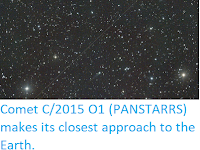Comet C/2016 M1 (PANSTARRS) makes its closest approach to the Earth
on Monday 25 June 2018 reaching a distance of 1.29 AU from
the
Earth
(1.29 times as far from us as the Sun, or 192 794 000 km). At this
distance the comet will not be naked eye visible, having a magnitude of
11.52, which means it would require a good telescope to observe it, and
then preferably in the Southern Hemisphere, as it is currently
in the
constellation of Corona Australis, which cannot be seen clearly from too far north of the
Equator.
Comet C/2016 M1 (PANSTARRS) imaged from Stockholm in Sweden on 14 August 2017. Image is a composite derived from 10 exposures, each of 240 seconds. Elongate structures are stars, comit is at centre of picture. Lars Bäckström/Spaceweather.
C/2016 M1 (PANSTARRS) was discovered on 22 June 2016 by the University of Hawaii's PANSTARRS telescope.
The name C/2016 M1 (PANSTARRS) implies that it is a non-periodic comet
(C/) (all comets are, strictly speaking, periodic since they all orbit
the Sun, but those with periods longer than 200 years are considered to
be non-periodic), that it was the first comet (comet 1) discovered in
the second half of June 2016 (period 2016 M) and that it was
discovered by the PANSTARRS telescope.
The orbit and current position of Comet C/2016 M1 (PANSTARRS) . The Sky Live 3D Solar System Simulator.
C/2016 M1 (PANSTARRS) has an estimated orbital period of 86 163 years and a
highly eccentric
orbit tilted at an angle of 90.99° to the plain of the Solar System, that
brings it to 2.21 AU from the Sun at perihelion (221% of the distance
between the Earth and the Sun, considerably outside the orbit of Mars);
to 3899 AU from the Sun at aphelion (3899 times as far from the Sun as
the Earth or 130 times as far from the Sun as the planet Neptune), between the outer Kuiper Belt and the inner Oort Cloud.
See also...
Follow Sciency Thoughts on Facebook.








